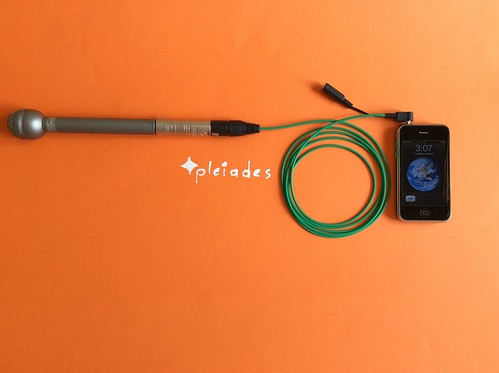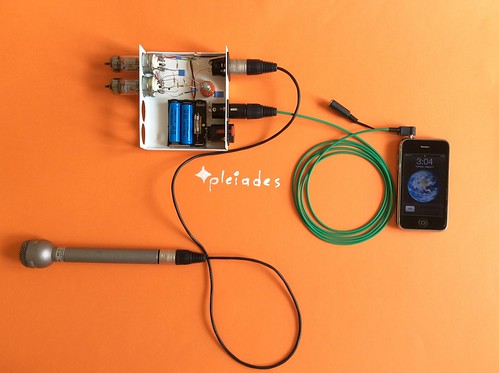Electro-Voice RE15 to Pleiades M073 step up transformer to Pleiades K117 preamplifier to iPhone, iPad or any device that accepts an electret condenser microphone

The Electro-Voice RE15 microphone is a variable D directional world class microphone. If we sing very close to it (one inch) like using all directional microphones we still get a great increase in mid bass and bass. Sensitivity may start increasing below 700Hz or even 1KHz in some directional microphones.
The mic is connected to a Pleiades input transformer. The primary inductance is deliberately low so that frequencies below say 700Hz are reduced in order to equalize the bass increase proximity effect. The Pleiades microphone transformer is inside the XLR adaptor made form Neutrik modules. This Pleiades microphone input transformer is wound on a state of the art Magnetec Nanocrystalinne tape wound core (metal glass) type M073. The primary winding is 30 turns, actually somewhat more is needed as the iPad Garageband has a low cut filter too. The secondary is 700 turns but actually less should be better as reasonance can be evident. Another XLR barrel adaptor containing a 100KΩ shunt (parallel) resistor can be connected at the output of the transformer to damp the reasonance.
The signal now is extremely clean and natural. Ambient low and mid low frequencies are extremely reduced becaude they do not excibit the proximity effect as they are far from the mic. We have maximum level from voice as we are extremely close and minimum level from anything less including bad acoustics.
Still this may be a small signal as the extra bass and mid bass have been reduced and we may like to be able to sing at speech level without putting effort to our voice. And we do not want any hiss (electron thermal noise or Johnson noise) to get in our way as it may be in a great recording studio.
The small and clean signal is passively amplified by the Pleiades step up transformer without adding any noise.
The Pleiades low noise JFET K117 preamplifier (inside black female XLR) matches the high output impedance of the Pleiades transformer to iPhone or iPad or any similar device. The circuit consists of just an K117 JFET and a 220Ω source resistor. As already mentioned a 100KΩ resistor may be needed to terminate the secondary of the mic transformer in order to damp an electric reasonance if it exists or is needed.
Devices like iPad have a resistor inside them which is connected to a positive voltage at the device side and becomes the drain resistor when the JFET preamplifier of an electret microphone capsule is connected.
So we use this to advantage to power the Pleiades K117 JFET preamplifier.
The signal by the time it enters the recording device is already clean, natural, devoid of any noise and high in level so the device is not given any chance to add its own noise.
Electro-Voice RE15 to Pleiades V5 electron tube preamplifier to Pleiades K117 JFET preamplifier to iPhone, iPad or any device that accepts an electret condenser microphone

Similar reasoning applies to the Pleiades V5 electron tube pre amplifier.
The microphone signal is applied to the Pleiades transformer made from the Magnetec brown M 060 core shown inside the V5 preamplifier.
Only 35 turns of primary winding are used to give a primary inductance of 47mH (millyHenries).
47mH gives an excellent natural response with a mic such as RE16 at 0 to 1 inch when its low cut is on.
The secondary of the Pleiades step up transformer is 350 turns increasing the mic signal by 10 times and impedance by 100 times.
The EF183 electron tubes in triode connection can operate at extremely low noise and extremely low battery voltage because the grid is positively neutralised by a 4.7MOhm resistor from Anode to Grid. This happened from a comment by Hliana who said that the grid must be positively charged to make electrons free.
The amplified signal from the 1st EF183 tube is applied to the second EF183 tube so and we can now drive it a bit harder and get that famous electron tube instant limiting sound with dynamics intact subjectively but compressed objectively as is done on all great recording studios.
The electron tubes are under-heated as is done on the Neumann U47 microphone for extremely low noise and maximum extraction of subtle information.
The very high, dynamically processed, extremely clean, hiss and noise free signal is attenuated at the output of the second EF183 electron tube to be brought back to mic level.
This signal is now fed to the Pleiades K177 JET pre amplifier to feed the iPhone, iPad or any other device. A 100KΩ resistor much be connected between V5 and K117 if it is not inserted inside the female XLR in order to make the JFET operate.
Pleiades circuit diagrams, schematics, and block diagrams shown on previous posts.
The sound is world class studio quality even if recorded in relatively noisy places with bad acoustics or
outdoors.

The Electro-Voice RE15 microphone is a variable D directional world class microphone. If we sing very close to it (one inch) like using all directional microphones we still get a great increase in mid bass and bass. Sensitivity may start increasing below 700Hz or even 1KHz in some directional microphones.
The mic is connected to a Pleiades input transformer. The primary inductance is deliberately low so that frequencies below say 700Hz are reduced in order to equalize the bass increase proximity effect. The Pleiades microphone transformer is inside the XLR adaptor made form Neutrik modules. This Pleiades microphone input transformer is wound on a state of the art Magnetec Nanocrystalinne tape wound core (metal glass) type M073. The primary winding is 30 turns, actually somewhat more is needed as the iPad Garageband has a low cut filter too. The secondary is 700 turns but actually less should be better as reasonance can be evident. Another XLR barrel adaptor containing a 100KΩ shunt (parallel) resistor can be connected at the output of the transformer to damp the reasonance.
The signal now is extremely clean and natural. Ambient low and mid low frequencies are extremely reduced becaude they do not excibit the proximity effect as they are far from the mic. We have maximum level from voice as we are extremely close and minimum level from anything less including bad acoustics.
Still this may be a small signal as the extra bass and mid bass have been reduced and we may like to be able to sing at speech level without putting effort to our voice. And we do not want any hiss (electron thermal noise or Johnson noise) to get in our way as it may be in a great recording studio.
The small and clean signal is passively amplified by the Pleiades step up transformer without adding any noise.
The Pleiades low noise JFET K117 preamplifier (inside black female XLR) matches the high output impedance of the Pleiades transformer to iPhone or iPad or any similar device. The circuit consists of just an K117 JFET and a 220Ω source resistor. As already mentioned a 100KΩ resistor may be needed to terminate the secondary of the mic transformer in order to damp an electric reasonance if it exists or is needed.
Devices like iPad have a resistor inside them which is connected to a positive voltage at the device side and becomes the drain resistor when the JFET preamplifier of an electret microphone capsule is connected.
So we use this to advantage to power the Pleiades K117 JFET preamplifier.
The signal by the time it enters the recording device is already clean, natural, devoid of any noise and high in level so the device is not given any chance to add its own noise.
Electro-Voice RE15 to Pleiades V5 electron tube preamplifier to Pleiades K117 JFET preamplifier to iPhone, iPad or any device that accepts an electret condenser microphone

Similar reasoning applies to the Pleiades V5 electron tube pre amplifier.
The microphone signal is applied to the Pleiades transformer made from the Magnetec brown M 060 core shown inside the V5 preamplifier.
Only 35 turns of primary winding are used to give a primary inductance of 47mH (millyHenries).
47mH gives an excellent natural response with a mic such as RE16 at 0 to 1 inch when its low cut is on.
The secondary of the Pleiades step up transformer is 350 turns increasing the mic signal by 10 times and impedance by 100 times.
The EF183 electron tubes in triode connection can operate at extremely low noise and extremely low battery voltage because the grid is positively neutralised by a 4.7MOhm resistor from Anode to Grid. This happened from a comment by Hliana who said that the grid must be positively charged to make electrons free.
The amplified signal from the 1st EF183 tube is applied to the second EF183 tube so and we can now drive it a bit harder and get that famous electron tube instant limiting sound with dynamics intact subjectively but compressed objectively as is done on all great recording studios.
The electron tubes are under-heated as is done on the Neumann U47 microphone for extremely low noise and maximum extraction of subtle information.
The very high, dynamically processed, extremely clean, hiss and noise free signal is attenuated at the output of the second EF183 electron tube to be brought back to mic level.
This signal is now fed to the Pleiades K177 JET pre amplifier to feed the iPhone, iPad or any other device. A 100KΩ resistor much be connected between V5 and K117 if it is not inserted inside the female XLR in order to make the JFET operate.
Pleiades circuit diagrams, schematics, and block diagrams shown on previous posts.
The sound is world class studio quality even if recorded in relatively noisy places with bad acoustics or
outdoors.
No comments:
Post a Comment